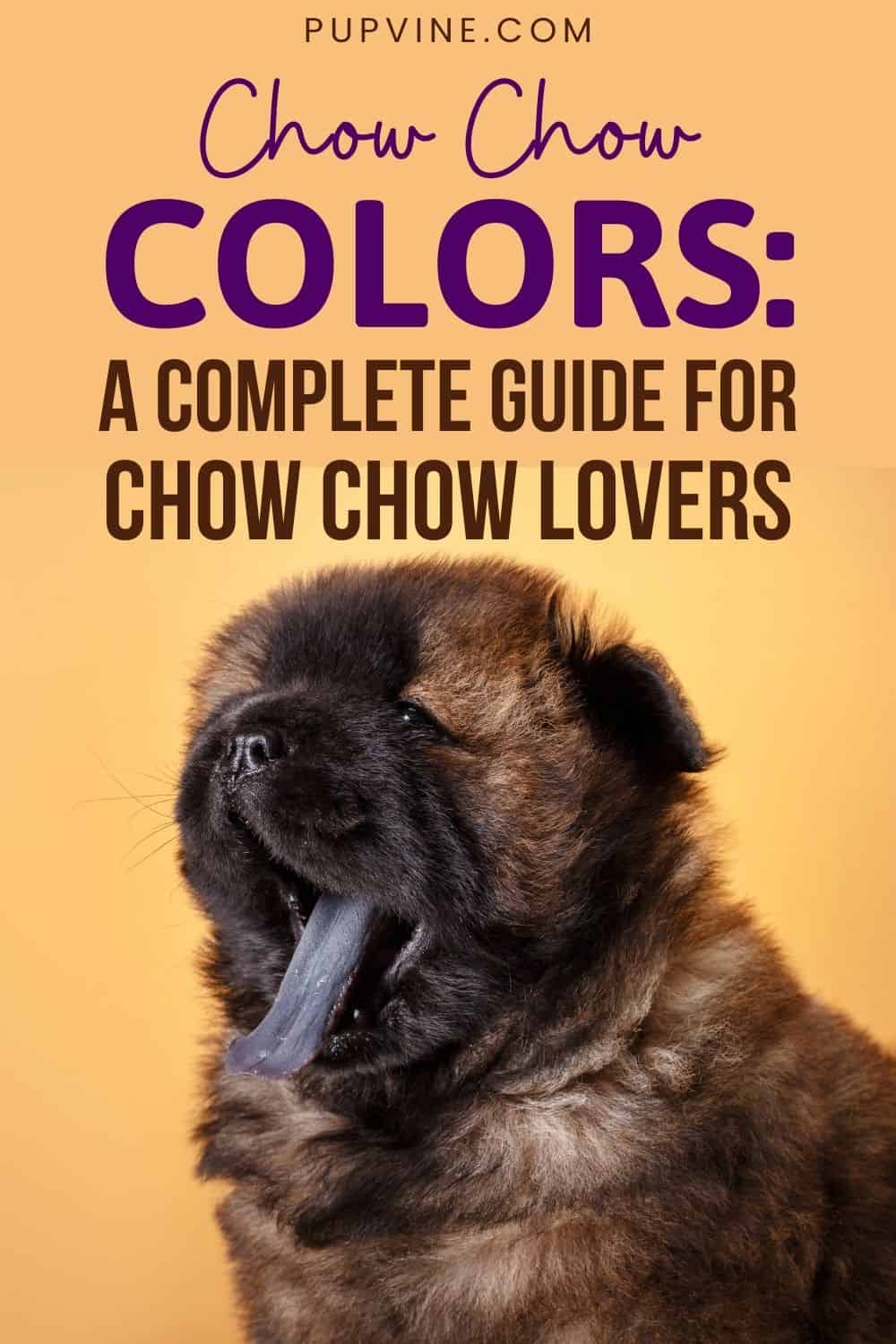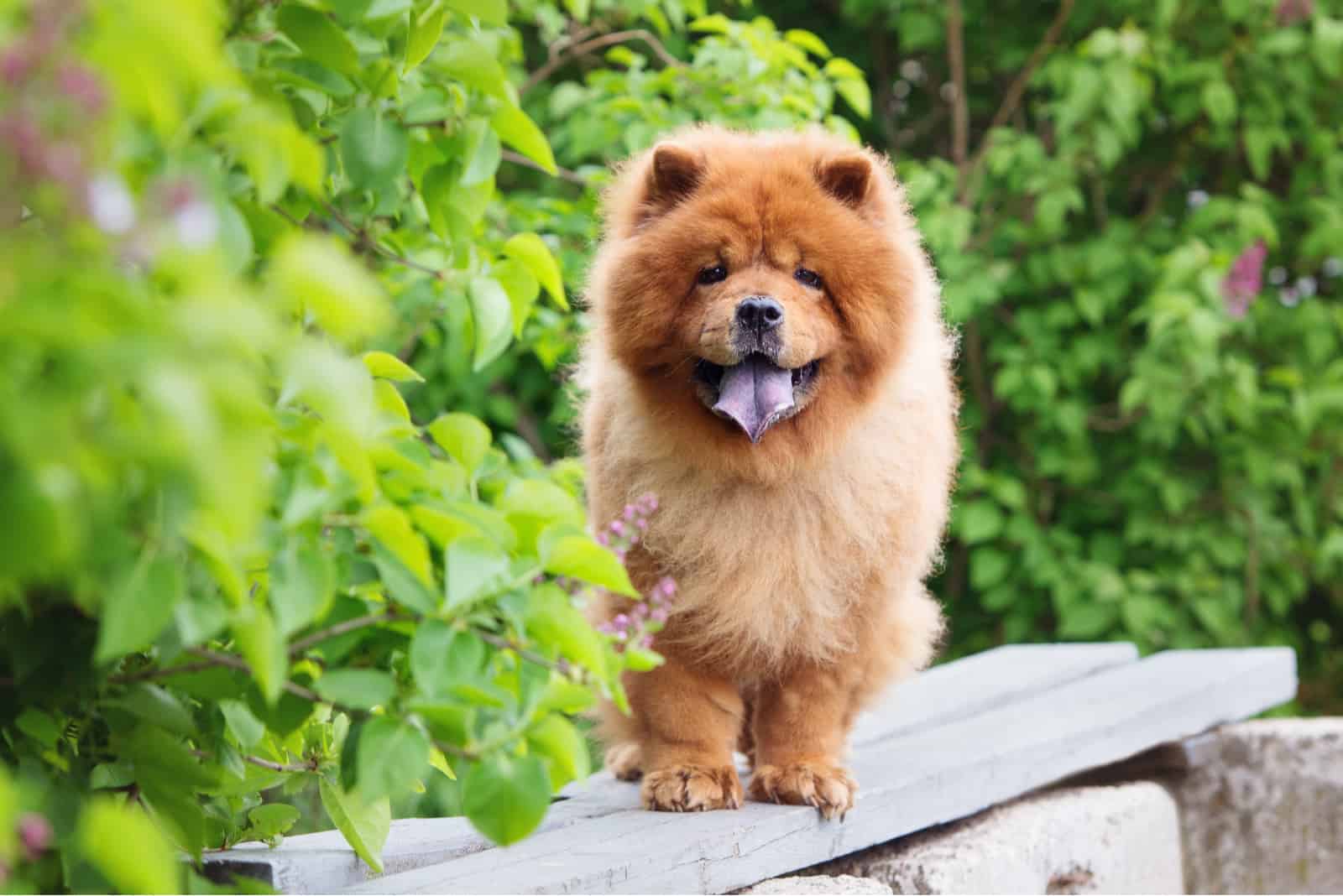The Chow Chow is a dog that is easy to recognize. With their long, fluffy coats and wrinkled faces, they are the talk of every dog park they’re in.
This ancient breed originates from Northern China and Mongolia, making it a rather exotic dog breed that has been recognized by the American Kennel Club (AKC) since 1903.
These are all-purpose canines that have served as working dogs (both herding dogs and guard dogs) and family pets. These are powerful, large dogs with a lion’s mane ruff that makes them stand out from the rest.
Chow Chows are known for their dignified behavior marked by their stilted gait, deep-set eyes, straight hind legs – and their hatred of getting their coats dirty. Yes, this is one of the cleanest dog breeds out there.
While we’re at dog’s coats, did you know that there are five Chow Chow colors recognized by the AKC, but you can find them in a few more rare colors? And that their fur comes in two variations – a common, rough coat, and a rarer, smooth coat?
If you’re looking to get this Chinese pooch for yourself, chances are you want to know all about Chow Chow colors and markings! We’re here to help you. In this article, you’ll find information about standard Chow Chow colors, as well as details about some rarer yet sought-after colors.
Here’s everything you need to know:
Chow Chow Color Chart
When it comes to Chow Chow colors, it’s important to know that not all colors are considered of the same value.
If you look at the chart below, you’ll see that some Chow Chow colors have been considered standard colors according to the AKC, while others are not.
The biggest difference is that the standard colors are naturally found in the dog’s genetics, and they are not correlated with any health issues.
Many rare coat colors are either found in the dog’s genetics due to mixing breeds sometimes in the past, or they are a result of mutation or some specific genes. This is why they are not as common as other, standard colors.
This Chow Chow color chart can give you an insight into how does AKC look at various shades and patterns:
[table id=329 /]
It’s important to keep in mind that different kennel clubs can recognize different coat colors, or they might use different names. For example, Canadian Kennel Club (CKC) doesn’t have cinnamon but calls it tawny instead. Similar to this, Federation Cynologique Internationale (FCI) calls cinnamon fawn, while also recognizing white coat color.
Also, neither the AKC nor any other major kennel club recognizes any coat markings. Chow Chows should always come in a solid color.
Chow Chow Coat Colors
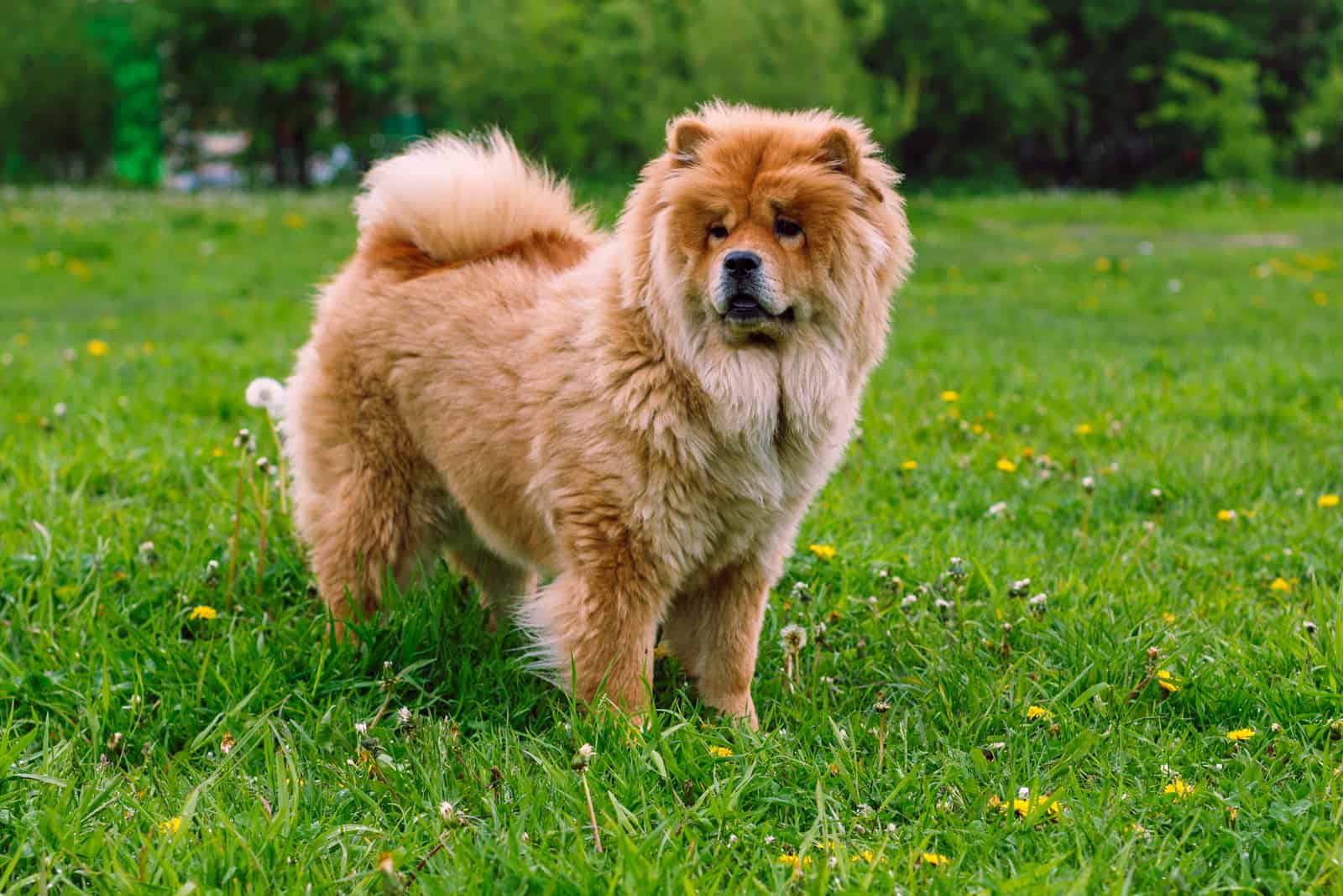
Fully understanding Chow Chow colors can be tricky, especially if you didn’t have the opportunity to see many of these colors in person before.
This is because some coat colors have a name that we might not connect with the specific color. For example, blue is a name for a specific shade of grey coat color, and not a literal blue color.
On the other hand, some dog breeds come in the same coat colors, but they are registered under different names. For example, French Bulldogs come in a taupe color called lilac. That same shade in Doberman will be called isabella.
Some color names are unique to a specific dog breed. For example, Shiba Inus come in sesame, and Chow Chows come in cinnamon.
To let you know what all these colors look like on Chow Chows, we’ll include pictures and descriptions of every coat color these dogs come in – as well as explain some rarer colors that are quite rare.
Here’s what they are:
Chow Chow Colors Black
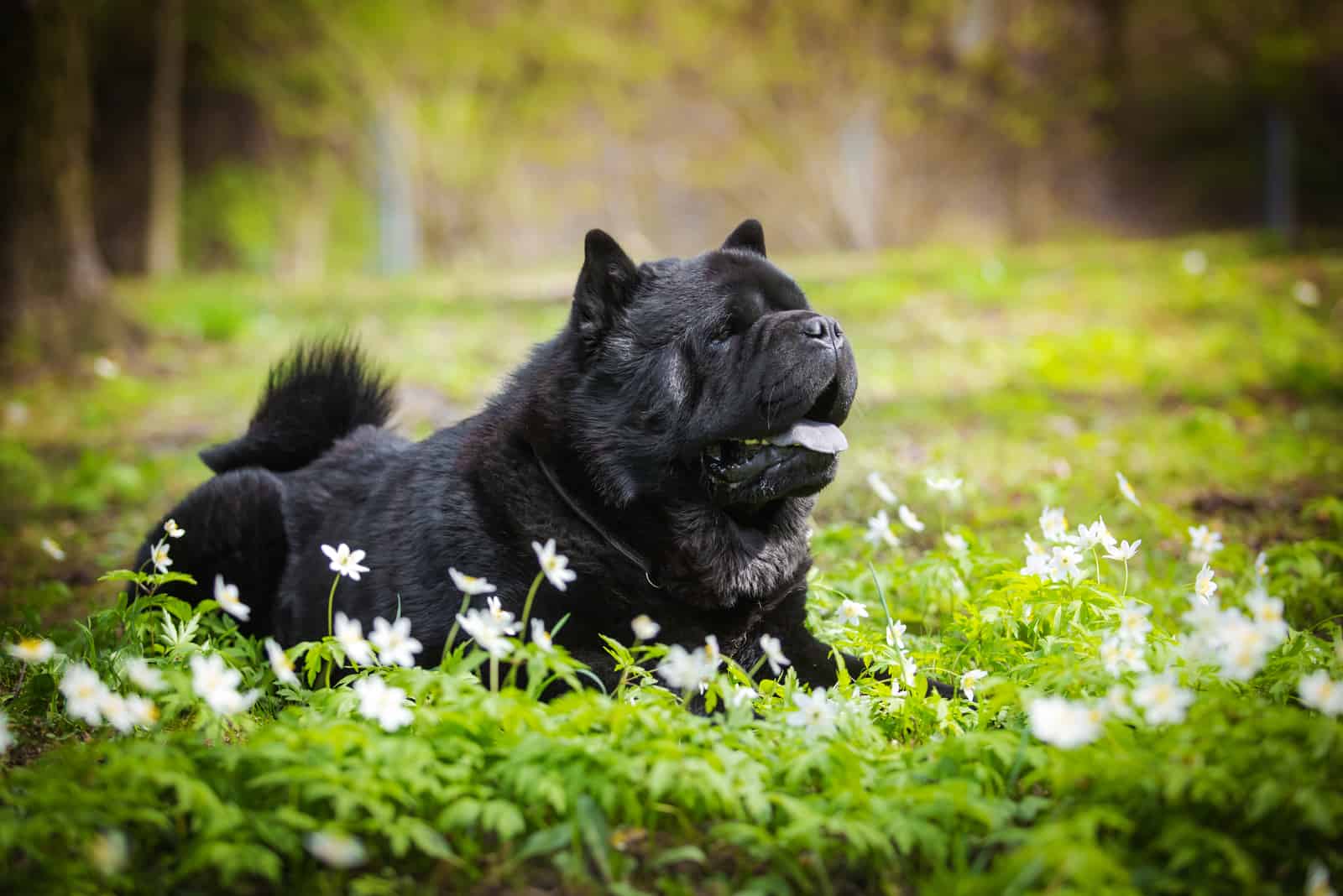
Black Chow Chows are very common and most breeders will have black Chow Chow puppies put up for sale. In fact, chances are the Chow Chows you’re seeing on the street come in black.
If you find black Chow Chow puppies, you’ll notice that their coats are pitch black but dull, without too much shine. This is because the coat type changes as the dog grows older, and this difference will be noticeable.
Once they become adult dogs, their coat might become a bit grayish, but it will get the shine these dogs are treasured for.
Black Chow Chows that are up to the breed standard also have a black nose and dark brown eyes.
Chow Chow Colors Red
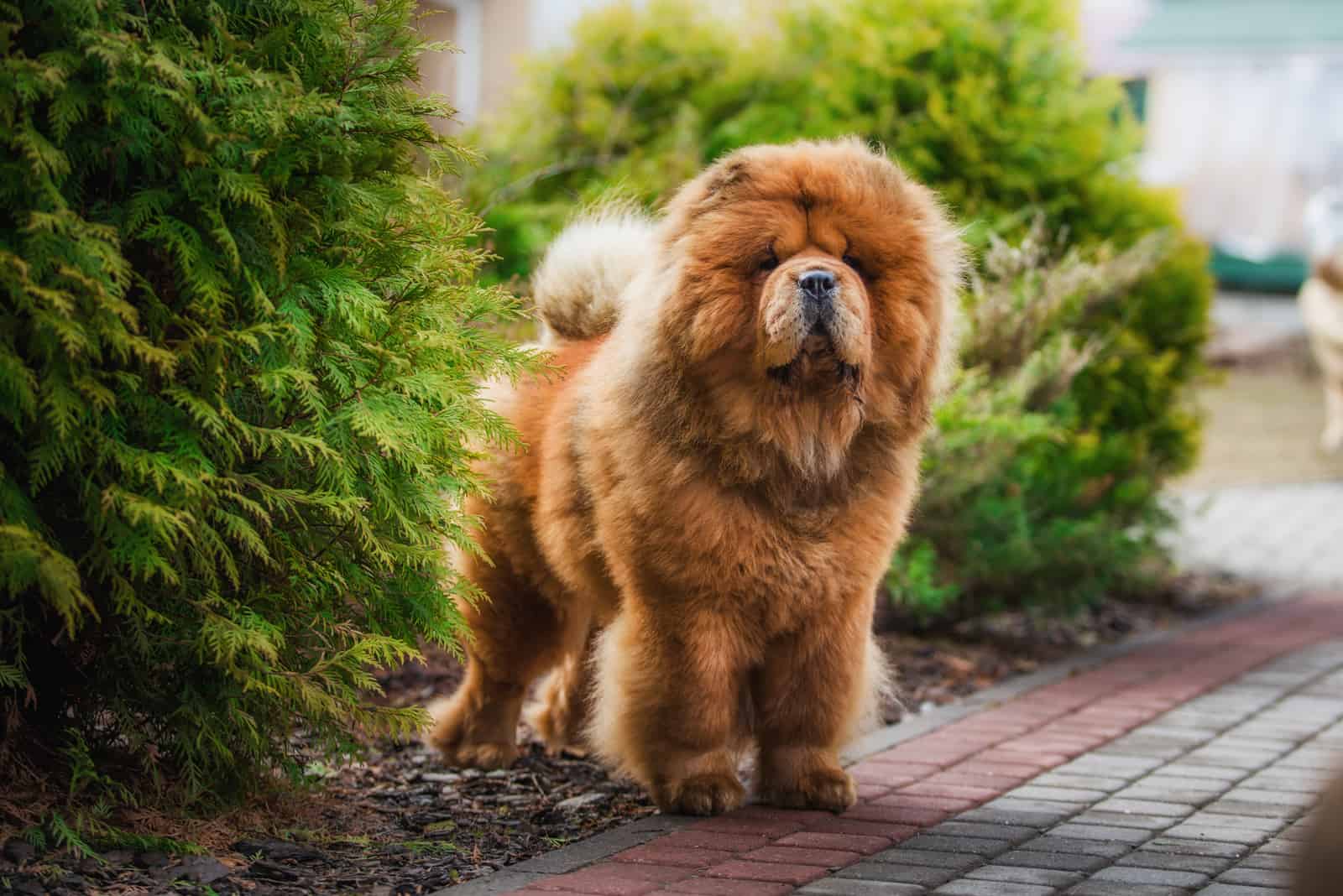
Red Chow Chows are hard to explain as they can come in many different shades. From light golden shade to a deep mahogany, all dogs with a reddish coat will be considered red Chow Chows.
You’ll know a dog is desirable by its white shadings on its tail, muzzle, breechings, and ruff. These dogs will be known as having a shaded red color.
However, these white shadings are not a necessity. A dog that is pure red in color can still participate in conformation shows, under the label self-red.
Red Chow Chows will also have black noses and dark brown eyes.
Chow Chow Blue Color
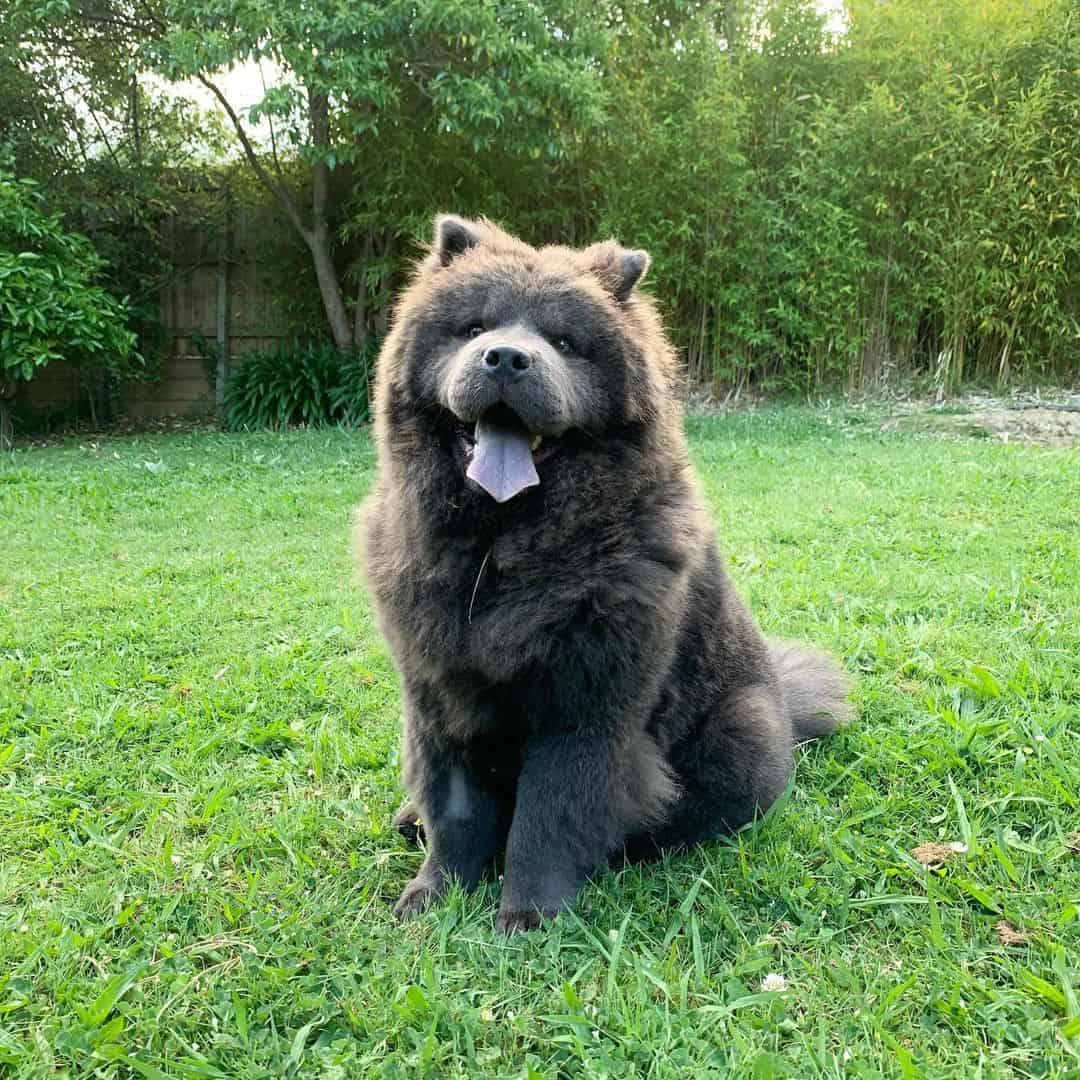
Photo from: @thechowgang
Blue is the result of a dilution gene affecting a black coat, something we’ll talk about in greater detail a bit later.
These dogs aren’t really blue but rather grey in shade. The most desirable shade is steel grey, but any type of silvery shade is good.
The muzzle and legs of blue Chow Chows can be a bit lighter or darker in shade, giving them the effect that’s known as salt and pepper.
Solid blue Chow Chows will always have a dark gray/blue nose, and most will have blue or grey eyes. This is because the dilution gene affects any black color on the dog’s body and not just coat color. True blue Chow Chows won’t have any black color on them.
Chow Chow Colors Cream
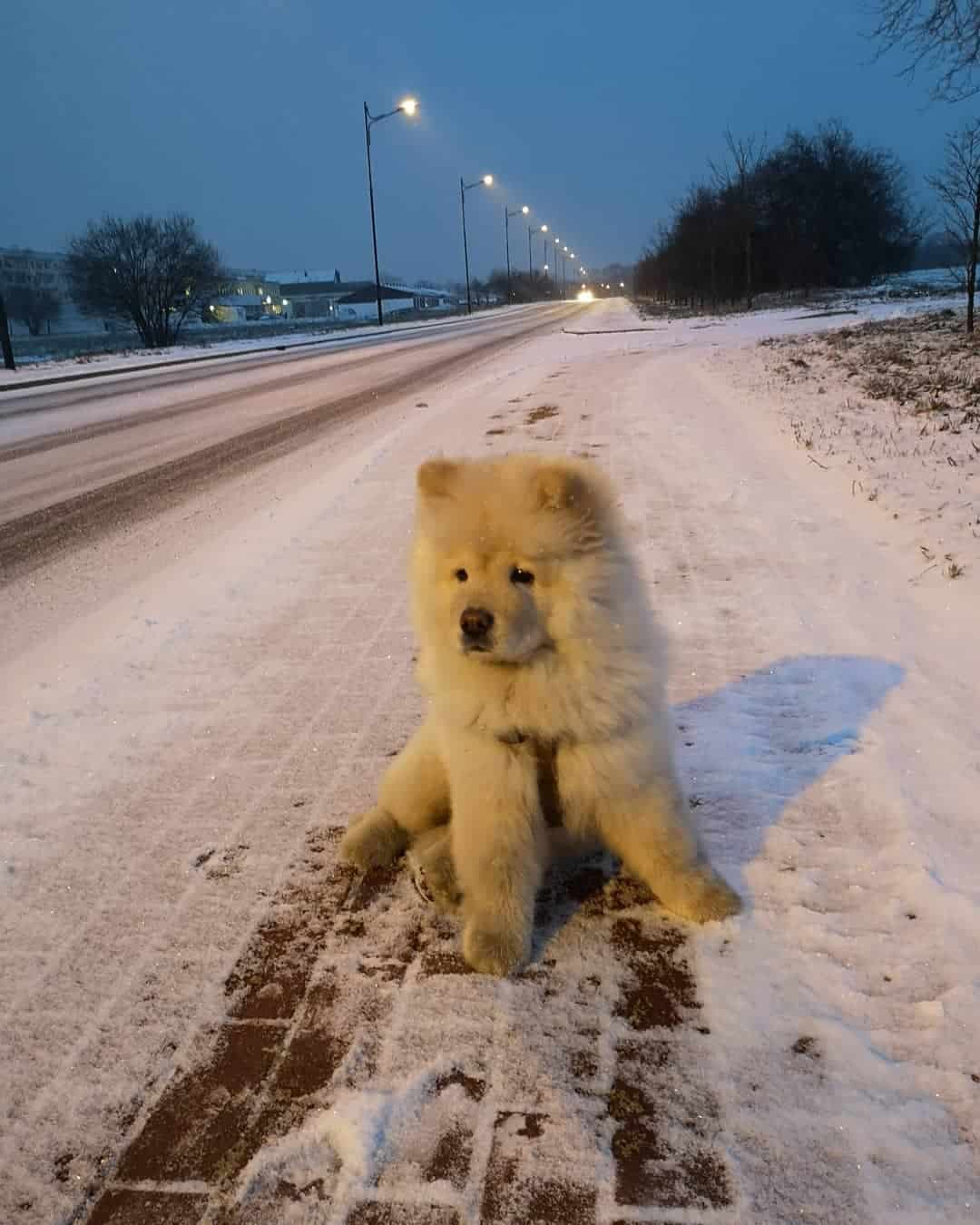
Photo from: @cream_chow_chow
Cream Chow Chows aren’t that common, which is why they are very popular and wanted. They have a gorgeous yellow shade that can vary from being ivory and almost white, all the way to red and butterscotch.
Unfortunately, most cream Chow Chows will not be able to participate in dog shows. This is because they will usually have a brown nose, which is not up to the breed standard.
Also, their eyes will usually be dark, but can sometimes be amber-colored, as well.
Cinnamon Chow Chow Colors
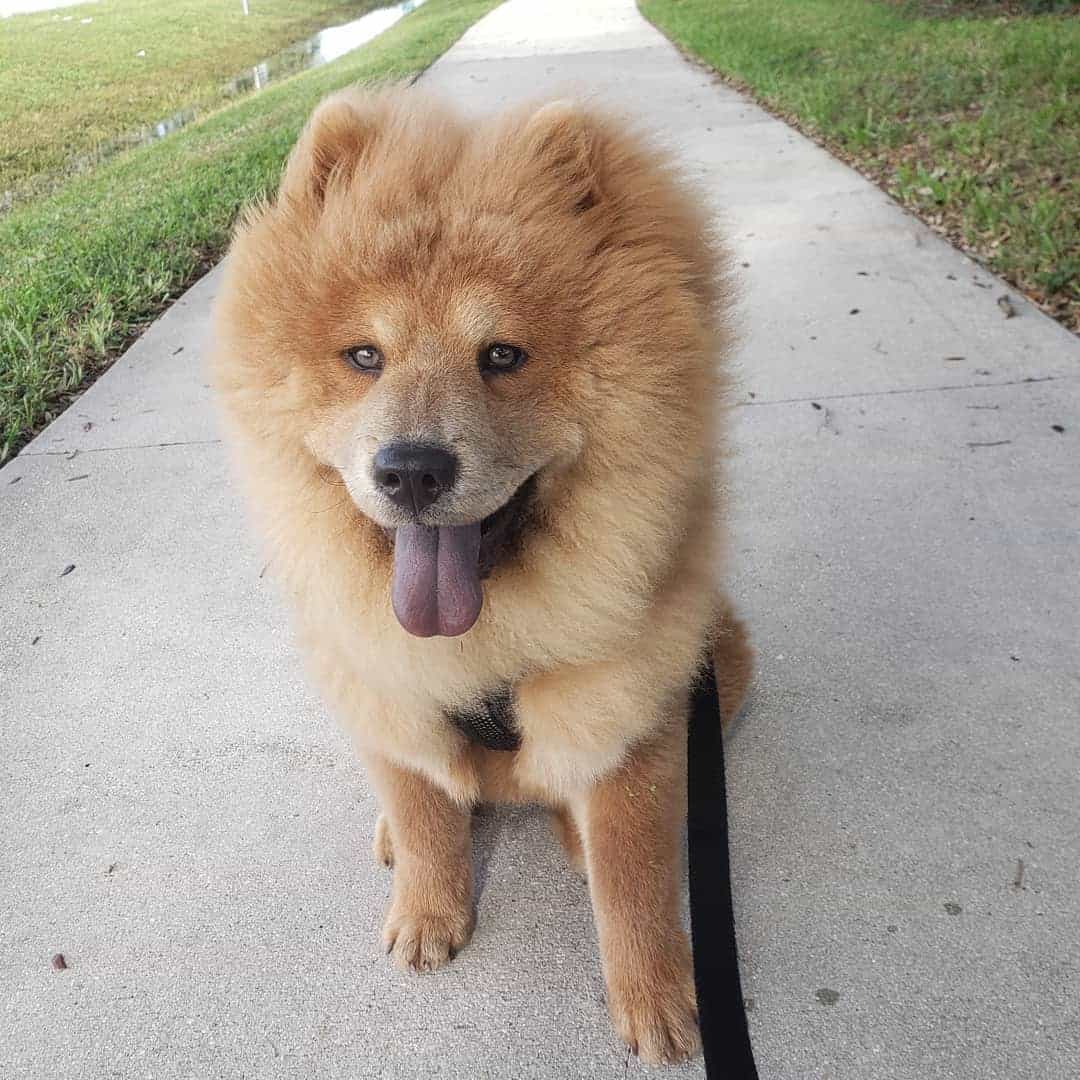
Photo from: @sammythecinnamonchow
Cinnamon is a color unique to the Chow Chow breed. Despite what you might think, it doesn’t look like cinnamon spice, which is why this color can confuse many dog lovers.
Cinnamon Chow Chows have a light beige coat that will gain a grey or pink cast as they grow older. This gives them a similar appearance to beige Chow Chows, although their color will usually appear to be duller in shade.
They can vary from having an almost white appearance to being a lot darker. This can confuse many dog owners and make them think their dog is bright red.
Cinnamon Chow Chows will have a mix of dark and light hairs on their muzzle and feet, giving them a similar effect to that blue Chow Chows have.
These dogs will have black noses and dark eyes, making them stand out from beige Chow Chows.
Chow Chow Colors Fawn
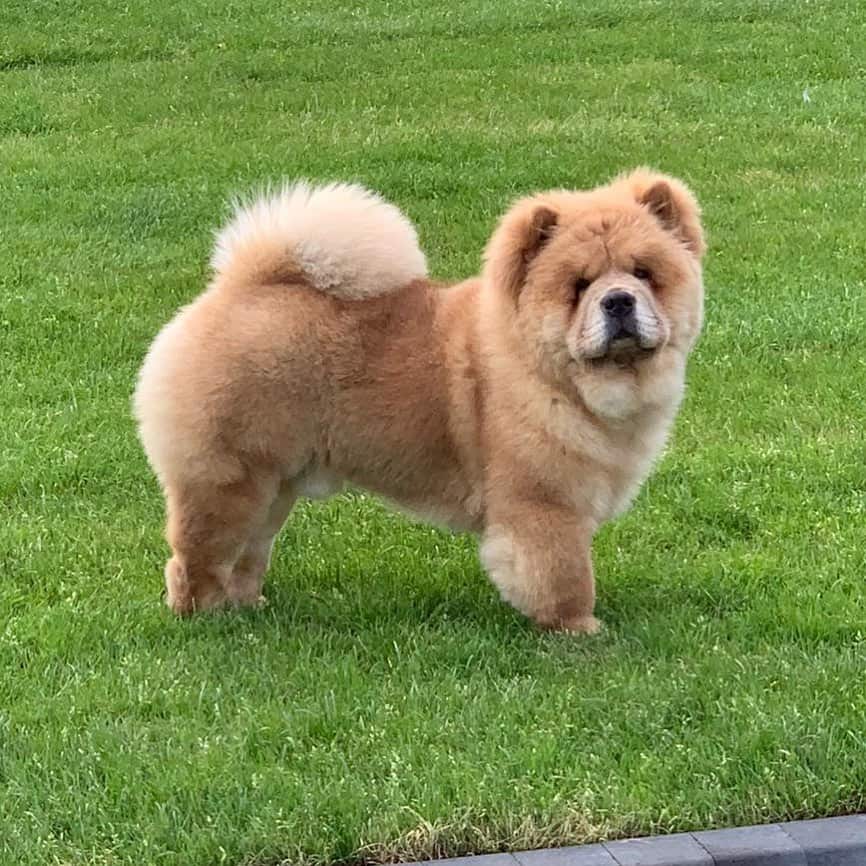
Photo from: @taio_foreverfawnchow
Chow Chows can sometimes come in a rare, fawn color. Fawn Chow Chows are, in fact, red Chow Chows with a dilution gene.
These pups have a rather pale or blue undercoat with a more yellow outercoat. If their undercoat is of a prominent blue shade, many breeders will try to sell their puppies as blue fawns, but this is the same color.
Fawn Chow Chows are easy to confuse with cream dogs, as they are very similar in shade. However, their nose will always be in liver color, and they’ll have a bluish tint standard cream Chow Chows don’t have.
As fawn Chow Chows have to have a brown nose, they are not according to the breed standard, so they are not recognized by AKC or most other major kennel clubs.
Merle Chow Chow Colors
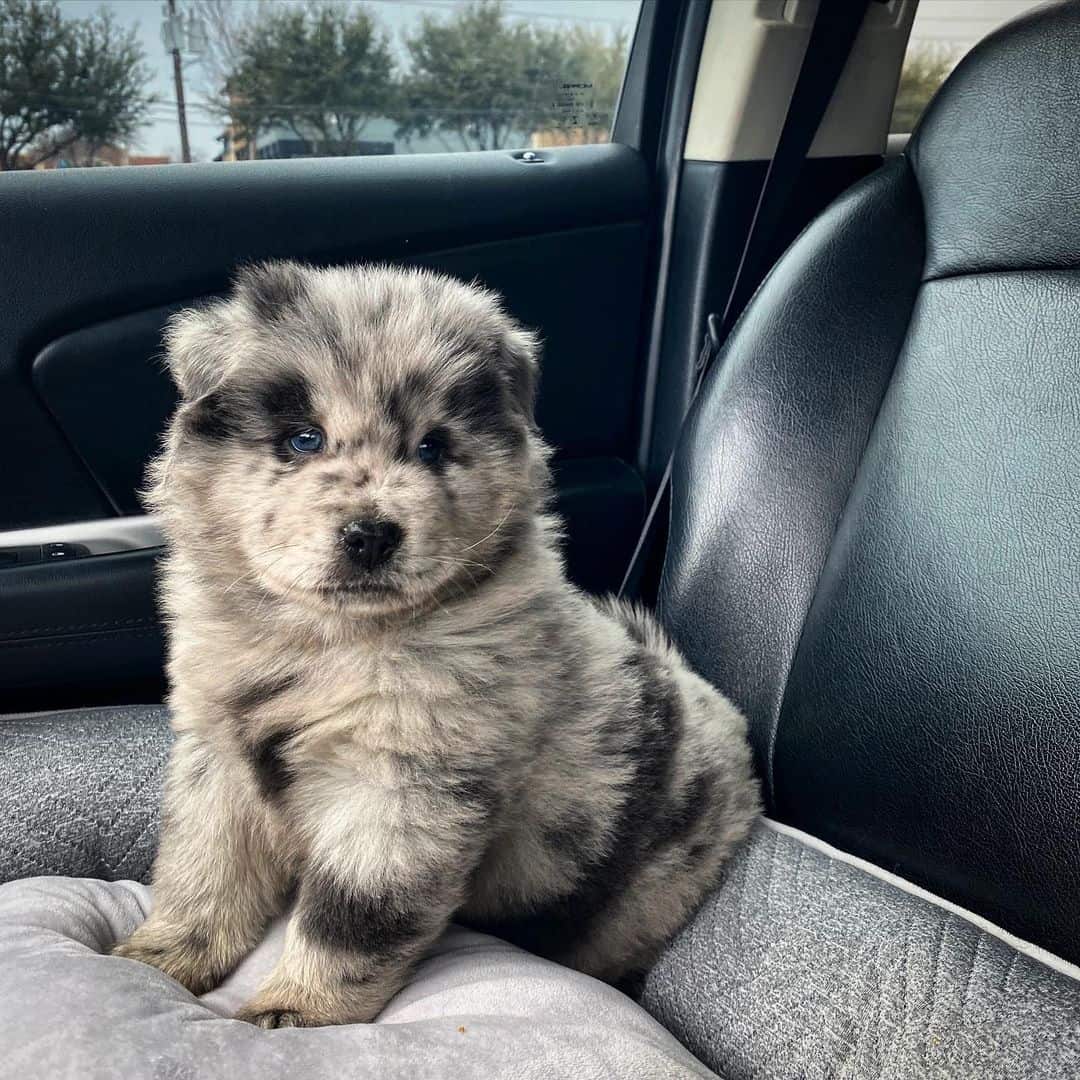
Photo from: @yoshithemerlechowchow
Merle is a unique coat color that no dog owner can stay indifferent towards. In fact, this isn’t a color but rather a pattern. A merle Chow Chow will appear tricolor, as he’ll have three shades of the same color.
The most common combination is black, blue, and white, but red, fawn, and white are also possible. The base color will usually be white, and the darkest shade will be irregular, giving a dog an almost spotted appearance.
This coat color is the result of a specific merle gene – a type of dilution gene that affects the base color. However, unlike the genes that turn the coat color into black or fawn, the merle gene will cause irregular dilution.
Merle Chow Chows will often have different colored eyes – a condition also known as heterochromia.
While beautiful, these dogs are not according to the breed standard. In fact, no reputable breeder will intentionally breed merles. Be patient – we’ll explain why a bit later.
Chow Chow Color White
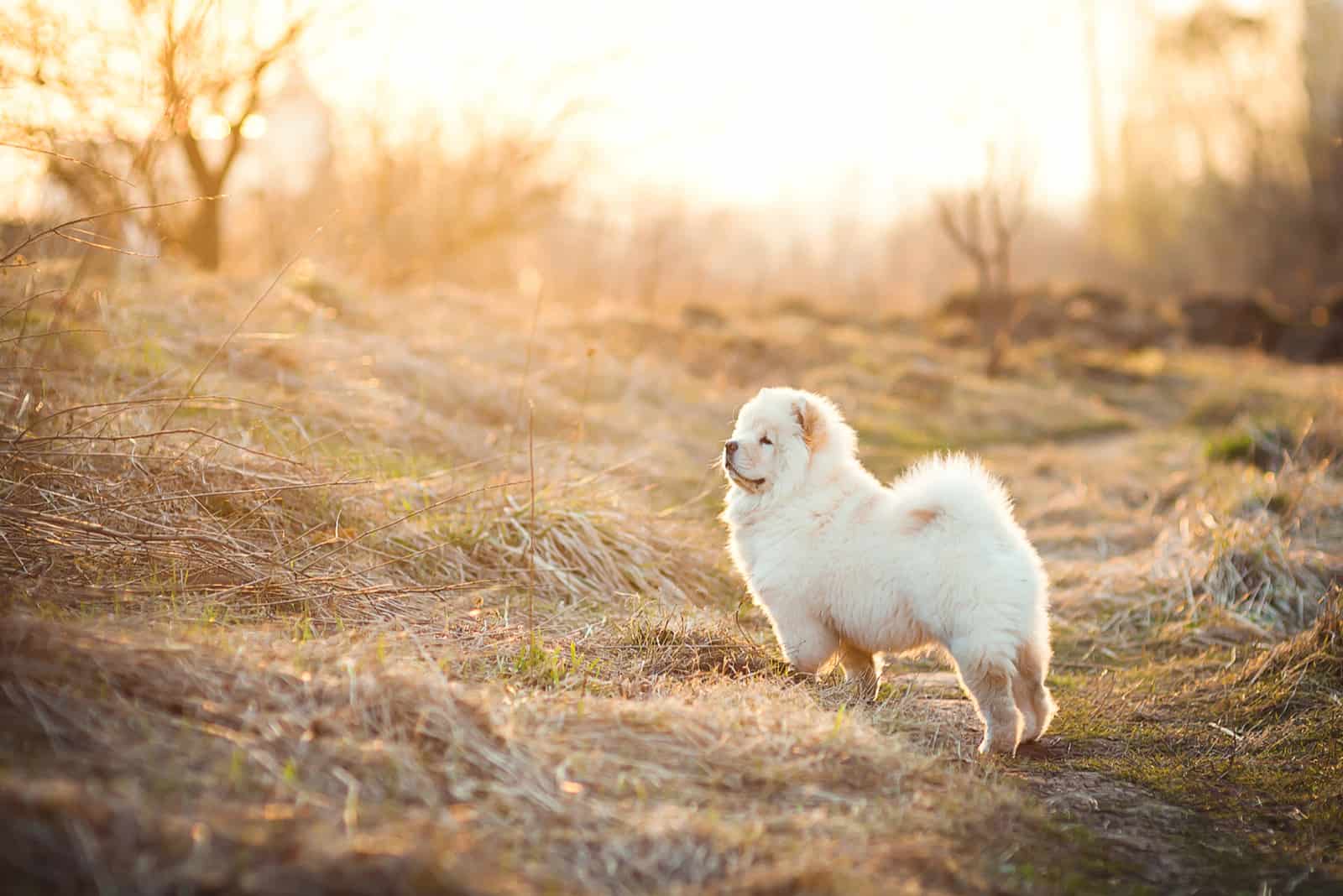
White is a fairly controversial color in Chow Chows. This is because it’s usually the result of the double merle gene or albinism.
As their name would suggest, white Chow Chows have a pure white coat. Chow Chows with albinism will also have bright blue or red eyes and a bright pink nose.
Double merle Chow Chows might have a colored spot here and there, and they might have a dudley or butterfly nose. Their eyes will usually be blue, but heterochromia is also possible.
The problem with white color is that it is associated with many health conditions – especially if it is caused by albinism. These dogs will have very sensitive skin and many will have plenty of other health issues, such as deafness or blindness.
Despite this, white Chow Chows seem to be very sought after. They have a royal appearance to them that makes them truly stand apart from other Chow Chows.
The albino Chow Chow’s hair might even have a transparent look to it, making it a beautiful sight. This is because the white color isn’t caused by a pigment, but rather by a complete loss in pigmentation.
Often, cream Chow Chows get confused with white Chow Chows. The best way to know whether your dog is cream or white is to look at the details.
A cream Chow Chow will have strands of yellowish hair, something that is impossible to occur on white dogs. Also, their nose and eyes will be darker.
Another way to know whether your pooch is cream or white is to take a look at his skin. Locations such as paw pads, lips, and eyelids are good places to check. A white Chow Chow’s skin will be bright pink.
Chow Chow Color Genetics
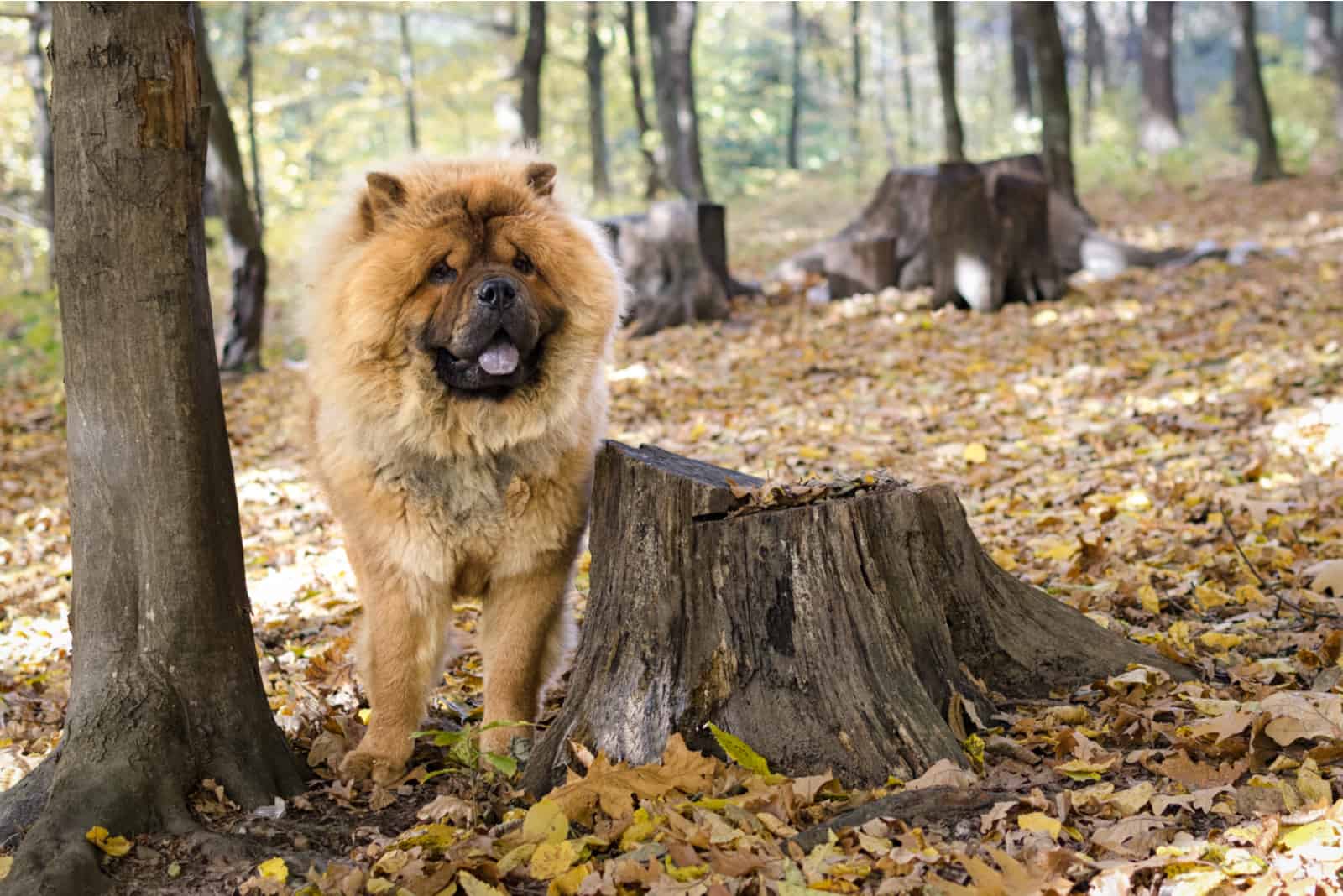
The dog’s entire appearance depends on his genes. Genes control everything in Chow Chow’s body, from lifespan to different colors his coat can have.
This might sound simple at first: You either have genes for a specific color or you don’t. However, it isn’t that straightforward. There is an almost infinite amount of possibilities and variations that will determine not just the Chow Chow color, but also the exact shade and patterns.
But first, let’s get into the basics. There are two types of pigment that determine Chow Chow color: eumelanin and pheomelanin.
Eumelanin is in charge of black pigment, and pheomelanin controls red and yellow shades. As such, if the dog has eumelanin, his coat will be black. If he has pheomelanin, he will come in red color.
But how come there are so many different shades and patterns if there are only two types of pigment?
This is because of various other genes that influence the exact shade. The most notable ones are the dilution genes.
While there are many various dilution genes, there are two most important ones that we’ve briefly mentioned:
• Blue dilution gene that will turn the base color into blue/gray shades.
• Liver dilution gene that turns base color into chocolate shades.
• The merle dilution gene.
These dilution genes will affect all the pigments on the dog’s body. This includes not just coat color, but skin color, as well.
In fact, blue dogs are recognized not just by their coat color, but by their nose color, as well. If a dog is cream but has a blue nose, this means he carries the blue dilution gene. The same goes for the liver gene.
This is also why it’s impossible to find blue Chow Chows or fawn Chow Chows with a black nose.
There are various other genes that will cause your dog to have a specific shade or a pattern, but dilution genes are the most prominent ones.
The Merle Gene Controversy
The merle gene is likely the most controversial dilution gene out there. While it is rarely naturally present in purebred Chow Chows, some breeders have brought it into the gene pool by crossbreeding.
Unlike most other dilution genes, the merle gene is dominant. This means that it is enough for a dog to inherit this gene from one parent for him to have this recognizable pattern.
In fact, this pattern is present only when the dog is a heterozygous merle, meaning he has one merle gene and a gene for some other pattern.
Merle Chow Chows are usually healthy, and the only thing that differentiates them from other Chow Chows is the unique markings they have.
However, the problem comes with double merles.
If a dog is a homozygous merle, or rather if he has two merle genes, the pattern usually won’t be present. Instead, he’ll be white in color, with strikingly blue eyes or heterochromia. A dudley or a butterfly nose will sometimes be present.
The issue is that the merle gene doesn’t just dilute coat color. Instead, it is linked with many health problems – most notably, vision impairment or conditions such as entropion, and hearing impairment.
Some research suggests that dogs with the double merle gene even have a higher chance of developing cardiac or bone conditions, including even hip dysplasia!
Because of this, the intentional breeding of merle dogs is frowned upon.
Sure, one merle gene won’t make a problem. However, supporting its existence inside the gene pool is a bad thing, especially as there are cryptic merles – dogs with a merle gene that don’t express the pattern.
As such, while merle Chow Chows exist, you’ll either find them at irresponsible breeders, or a breeder didn’t know that his dog is a cryptic merle.
Either way, a merle dog should be spayed and neutered to prevent further reproduction.
Chow Chow Eye Color
Chow Chow eye color can depend on their coat color – to an extent.
The standard eye color for Chow Chows is dark brown, and this is what AKC recognizes.
However, a Chow Chow might also come with light brown, amber, or even green and blue eyes depending on its genes – most notably, dilution genes.
For example, the blue dilution gene will cause the dog’s eyes to lose their dark brown color and turn them bluish instead. In fact, it is impossible for a blue Chow Chow to have brown eyes, as brown eye color is closely connected with eumelanin and black pigment.
On the other hand, liver dilution will turn the eyes into an amber or green color.
Merle gene turns eyes into bright blue color, or gives them two different colors, while albinism can even turn eyes red as they’ll lose pigment.
If you’re looking for a show-quality dog that will be entirely up to the breed standard, you’d want a dog with deep-set, dark eyes, even though lighter brown colors usually won’t mean disqualification from dog shows.
However, green and blue eyes, unless they are connected with the blue Chow Chow color, are not according to the standard. Such a dog will be deemed faulty and you likely won’t be able to have him participate at conformation shows.
Chow Chow Tongue Color
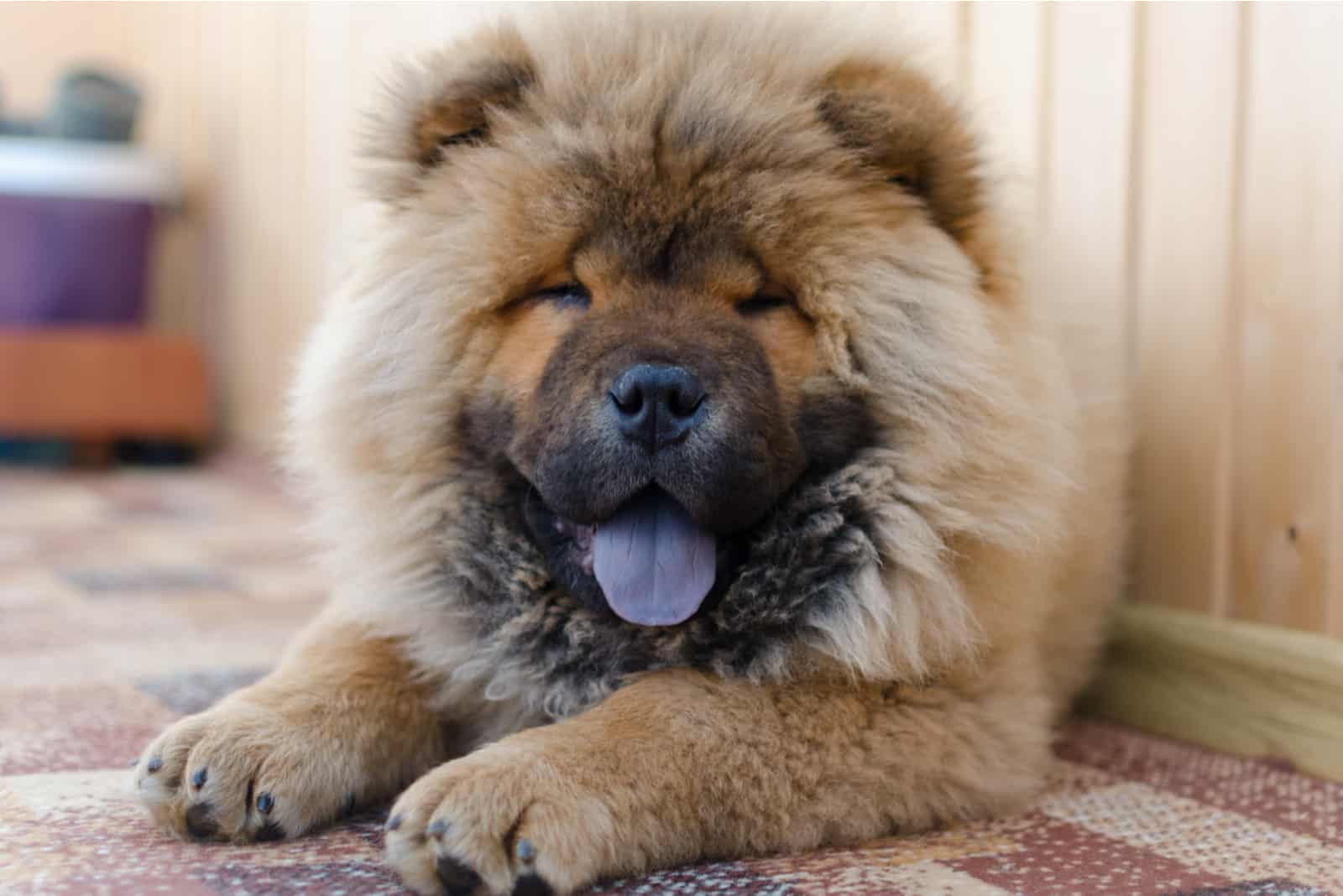
There’s one trait that makes Chow Chows rather unique, and this is the color of their tongue.
No, this isn’t your imagination and you have seen it correctly. Chow Chows have a blue-black tongue color.
This doesn’t mean that the dog is sick or that he belongs to some unique species. In fact, there is a rather simple reason behind the color of their tongues.
Before we explain, we’ll name a few fictional reasons why these pups might have a blue-colored tongue.
According to one Chinese legend, Chow Chows were there when the world was created and they were allowed to lick the sky, coloring their tongues.
Another legend states that Chow Chows are a crossbreed between canines and bears and that this is why they have a bear-like tongue.
Their blue tongs even lead to them being exhibited at the London Zoo, where they were called Chinese wild dogs.
In fact, the blue tongue is the main reason why this breed was mass-bred in Europe and the U.S., and it’s also one of the signs that the dog is purebred.
Chow Chows are not the only dogs with a blue tongue. Their distant relative, Shar-Pei, also has a tongue in this striking color.
Why Is Chow Chow’s Tongue Blue?
Despite the numerous legends, there is a genetic cause of the dog’s tongue color. In fact, it simply contains pigmented cells that are in black-blue color.
The same type of cells is present in numerous wild animals, such as bears and giraffes. This is where the many legends about Chow Chows being related to bears come from.
In fact, some research suggests that Chow Chows are direct descendants of Hemicyon, a unique animal that lived in the Miocene age that is something between a bear and a dog.
One of the reasons why scientists think this might be the case is because Hemicyons had 44 teeth – another trait they share with Chow Chows. Compared to this, the standard number of teeth a dog has is 42.
Do Chow Chow Puppies Change Color?
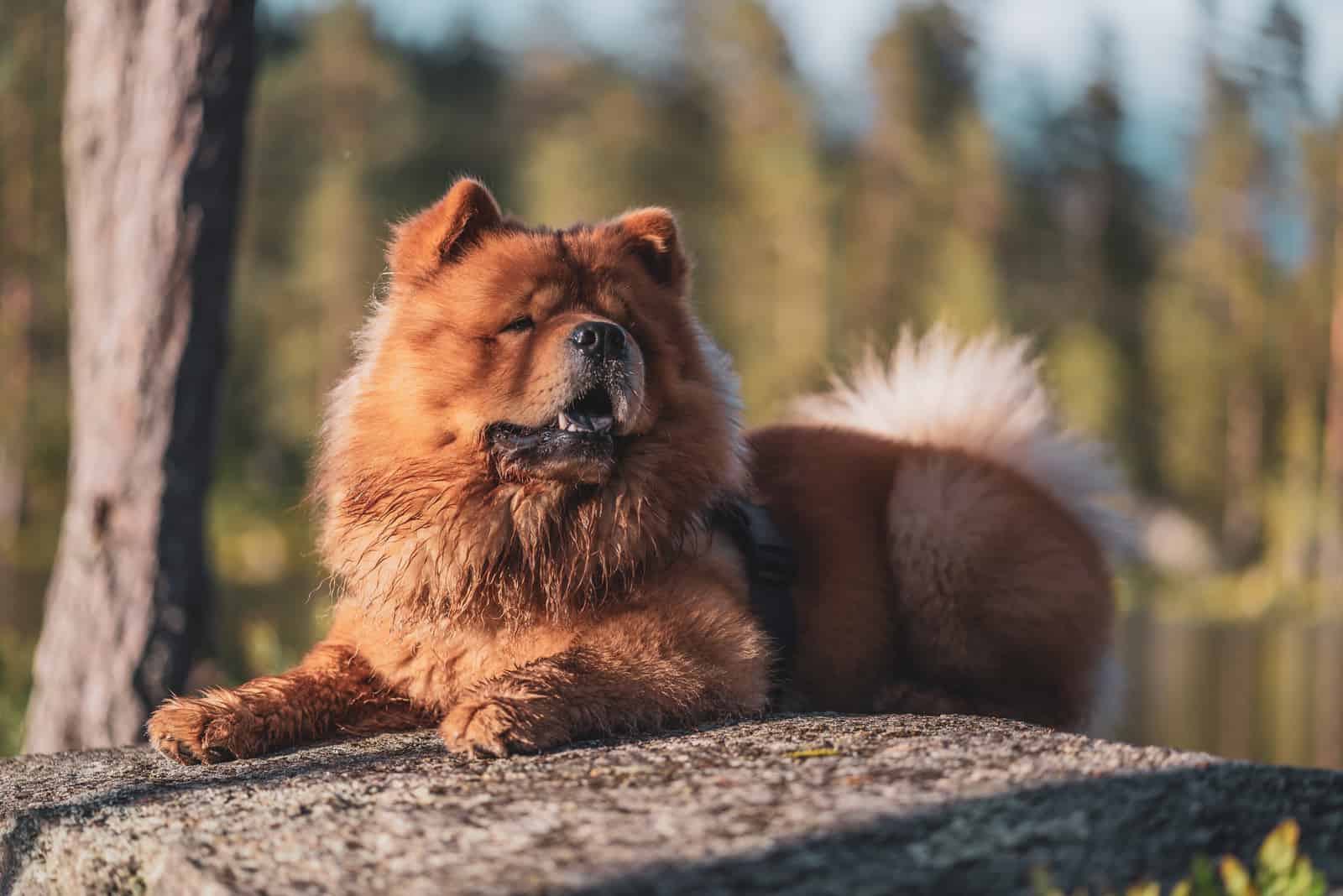
Chow Chow breed is known for its changing coat color. Just because a puppy is born with a specific shade doesn’t mean he’ll stay that same shade once he is older.
For example, black Chow Chow puppies are known to become paler as they grow older. Many will appear to have a really dark gray shade instead of being pure black.
Not just that, but black Chow Chows can get a rusted appearance if they’ve been out on the sun for too long. They’ll have a reddish shade that many dog owners consider undesirable.
As such, if you don’t want your black Chow Chow to change color, keep him out of the sun. Otherwise, he might end up looking more chocolate than black.
The same can happen to blue Chow Chows, as they carry the same gene for a black coat as black Chow Chows do. In fact, this rusting effect can be even more noticeable on blue dogs than on black ones.
Black Chow Chows are not the only ones prone to color change. The same happens to red Chow Chow puppies, as well. They will be born with a mousy brown coat and have a black mask. Both will fade over time and the dog should reach his true color by the time he is one year old.
Cinnamon Chow Chows are also not born in this shade. Instead, they’ll have a bright silvery color and a dark mask while they are puppies. Only later will they turn into a beige color.
Does Chow Chow’s Tongue Change Color?
Just like with coat color, a Chow Chow tongue will look differently from puppyhood to adulthood.
In fact, Chow Chows are born with regular, pink tongues. Their tongues will darken and turn black blue as they grow older. Most dogs will have their tongues entirely blue by the time they are 3 months old.
Sometimes, a Chow Chow’s tongue will remain pink. However, this is the indication that the dog isn’t purebred but is a mixed breed.
Does Chow Chow Color Matter?
In one way, it is important what Chow Chow color you choose.
Standard coat colors are there to let you know your dog is purebred (although this isn’t the only indication). These colors occur naturally in the dog’s genetics. Most rare colors, although beautiful, come from some other dog breed that has been mixed with Chow Chows.
Some coat colors, such as merle, are even linked with an increased risk of health problems!
Finally, choosing a rare color or a color that isn’t within the breed standard means your dog won’t be able to participate in dog shows. If this is something that’s important to you, you need to stick to colors that represent the breed.
In any other sense, Chow Chow colors aren’t that important.
No matter the Chow Chow color, these dogs make amazing pets – even though they are somewhat shy, so early socialization is essential to making sure they are on their best behavior.
It’s no wonder why some prominent women, such as Martha Stewart, have chosen this dog breed as their companions.
Even many royals loved these cute living teddy bears, including the Han Dynasty and Queen Victoria!
Still, there’s one thing to keep in mind: All Chow Chows have a double coat. This includes a thick undercoat and a long overcoat.
While this is what gives them that fluffy appearance, a double coat also means that Chow Chows shed – a lot. You’ll likely spend hours brushing them!
Another thing that makes grooming all the more complicated is the size of these pups. Chow Chows are large dogs, which means more hair – which means more shedding.
If you don’t mind picking up dog hair every day or paying a hefty sum for a purebred dog and would love to have a gorgeous dog that will be loyal to the core, Chow Chows might be the right dogs for you.
As for the color – pick the one you like! It won’t affect his temperament in any way. You can also choose a cute Chow Chow name to go with his coat!
Read Next: Red Cantonese Bear Dog: Does It Exist Or Is It A Hoax?
